2012 Annual Oxygen Market Analysis
Oxygen Providers Push Forward
After surviving Round One of Competitive Bidding, oxygen providers embrace portable oxygen, prepare for Round Two, and receive news regarding what to expect from SCOTUS.
- By Joseph Duffy
- Aug 01, 2012
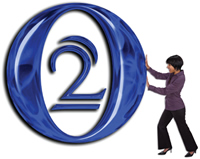 There just doesn’t seem to be a limit to the number of challenges the oxygen industry can encounter. Cuts, caps and competitive bidding have contributed to the results of our annual oxygen survey for some time now, and this year is no exception. Respondents wait for the far-reaching results of Round Two of competitive bidding, which will introduce new opportunities and roadblocks in 2013. And although announced after this year’s survey closed, the Supreme Court upheld the 2010 Patient Protection and Affordable Care Act, which contains several provisions that will impact the HME industry.
There just doesn’t seem to be a limit to the number of challenges the oxygen industry can encounter. Cuts, caps and competitive bidding have contributed to the results of our annual oxygen survey for some time now, and this year is no exception. Respondents wait for the far-reaching results of Round Two of competitive bidding, which will introduce new opportunities and roadblocks in 2013. And although announced after this year’s survey closed, the Supreme Court upheld the 2010 Patient Protection and Affordable Care Act, which contains several provisions that will impact the HME industry.
But through the bombardment of changes and challenges, an evolution might be occurring, as providers try to find more affordable ways to do business. For example, last year, respondents said that the No. 1 choice for best describing their oxygen delivery business model was “stationary concentrators and oxygen cylinder delivery only” (34.5% of respondents). This year, the No. 1 choice was “a mixture of equipment options with emphasis on transfilling systems and or POCs” (43.5%), up from 23.6% in 2011. And like last year, with a majority of respondents reporting some growth in the past 12 months, providers are finding ways with service cuts and new technology to keep their doors open. Here are some survey highlights:
- 61.2% of respondents said their business grew over the last 12 months. This is slightly lower than last year (63.4%), but survey-takers saying their business didn’t grow was down about 1% from last year.
- 32.4% said the 36-month oxygen cap created the greatest challenge in the past 12 months, down from last year’s respondent rate of 40.4%.
- 59% said they weren’t considering exiting the oxygen business in 2013 due to competitive bidding, the 36-month oxygen cap and other Medicare caps, compared to 57% last year.
OUR RESPONDENTS
The majority of 2012 survey-takers were respiratory HME business owners (48.1%), followed by respiratory therapists in a homecare company and respiratory service managers, both comprising 25.9% each of all respondents.
The majority of respondents have a respiratory client base containing COPD patients.
- 34.5% said 51% to 75% of their client base has COPD.
- 29.9% said 25% to 50% of their client base has COPD.
- 19.5% said more than 76% have COPD.
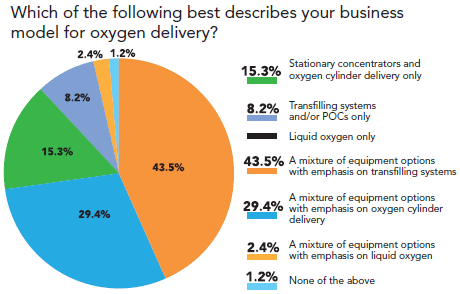
As reported earlier, respondents’ most popular business model for oxygen delivery has changed from last year. With all the attention POCs and transfilling systems are receiving due to cost-cutting approaches and technological advances, it is not entirely surprising that most respondents (43.5%) said that a mixture of equipment options with emphasis on transfilling systems and/or POCs best described their current business model. A mixture of equipment options with emphasis on most popular model, according to 29.4% of survey-takers. The factors that were highly influential for respondents to use their particular business model were cost (58.3%), 36-month cap (54.2%) and competitive bidding Round Two (31%).
Last year, 64.6% of respondents said they had a program to service traveling oxygen patients (23.9% said they didn’t have a program and 11.5% contracted POC rentals). In 2012, 82.4% of survey-takers said they have a program to service traveling oxygen patients. Only 14.1% said they didn’t have a program and 3.5% contracted POC rentals.
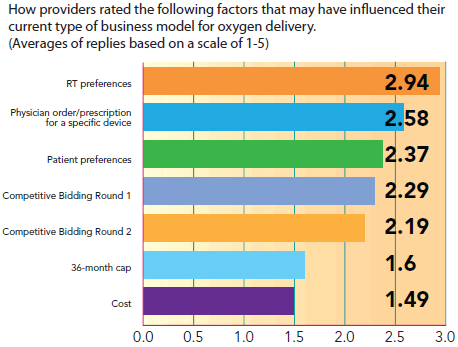
Overall, as reported earlier, 61.2% of respondents said that their oxygen business has grown over the last 12 months. The No. 1 reason cited was an increased number of patients due to referral sources (51.6%). When asked if their oxygen business has contracted (shrunk) in the past 12 months, 71.1% of respondents said no, while 21.7% said yes. For those survey-takers with contraction, 25.9% said decreasing Medicare funding due to the rental cap or other developments with Medicare funding most contributed. Another 25.9% of respondents said they were unsure of what most contributed to
their contraction.
CHALLENGES
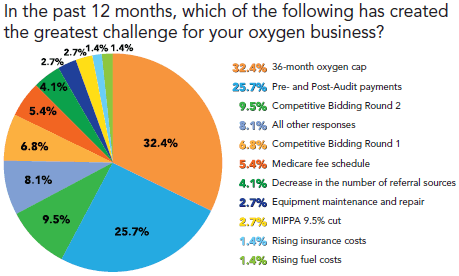
For the third year in a row, the 36-month oxygen cap was named the No. 1 challenge for oxygen businesses, according to 32.4% of respondents. Last year, it received 40.4% of respondents. Where competitive bidding was the No. 2 greatest challenge to oxygen business in 2011, this year competitive bidding Round Two came in at No. 3 (9.5%) and Round One at No. 5 (6.8%). Pre- and post-payment audits were the second greatest challenge, according to 25.7% of respondents, which is up from 12.1% in 2011.
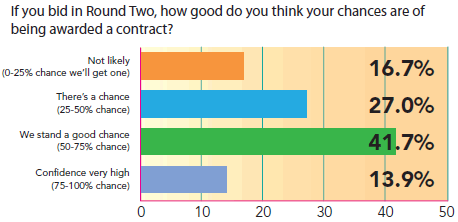
With the results of Round Two of competitive bidding quickly approaching, 47.3% of survey-takers said their company was part of Round Two bidding. Here is what they had to say about Round Two:
- 63.6% of respondents not participating in Round Two will
reduce services. - 45.5% will reduce staff.
- 45.5% will build up their retail business.
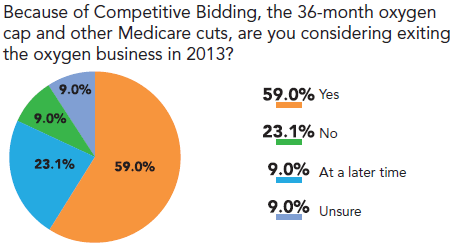
WHO ARE YOUR PATIENTS?
Just more than 95% of survey-takers said that COPD is the primary diagnosis for their oxygen patients, compared to 82.1% in 2011. After COPD, the most common diagnosis is:
- Congestive heart failure (52.4%).
- Sleep apnea (16.7%).
- Pulmonary hypertension (7.1%).
COPD patients tell providers that they most want access to portable technology, according to 79.2% of respondents, up from last year’s 75%. Following wanting portable technology, 13% of respondents said patients want more comfortable technology.
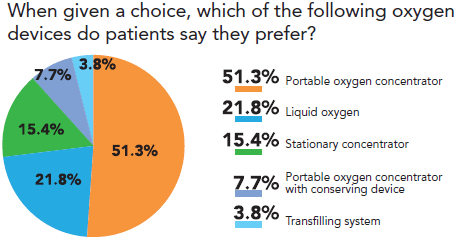
When given a choice, patients say they prefer the following oxygen devices:
- 51.3% of respondents said they prefer portable oxygen
concentrators. - 21.8% said portable oxygen cylinder with conserving device.
- 15.4% said transfilling system.
When it comes to features, respondents said the following about certain oxygen device features and how they relate to patients:
- Weight: 59.7% of respondents call it most important while 37.7% call it important.
- Ease of use: 38.5% call it most important while 51.3% call it important.
- Portability: 59.7% call it most important while 37.7% call it important.
- Energy efficiency: 11.7% call it most important while 42.9% call it somewhat important.
This article originally appeared in the Respiratory & Sleep Management August 2012 issue of HME Business.
About the Author
Joseph Duffy is a freelance writer and marketing consultant, and a regular contributor to HME Business and DME Pharmacy. He can be reached via e-mail at [email protected].